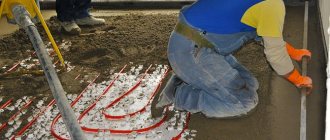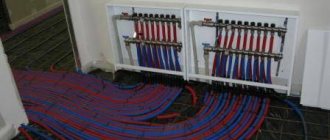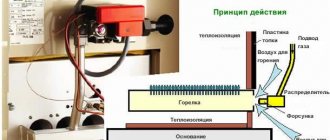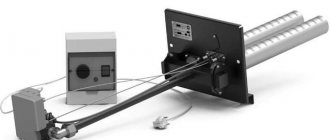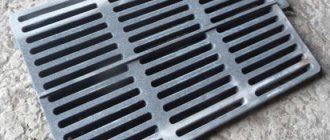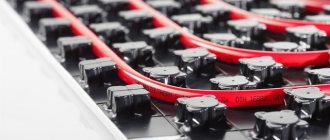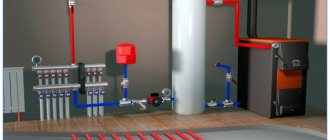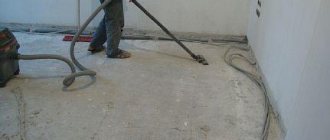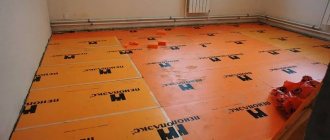Home |Construction |Do-it-yourself heated floor screed
Date: June 26, 2017
Comments: 0
Heated floors compete with traditional types of heating, creating a comfortable temperature in the room. Regardless of the method of floor heating and the coolant used, the screed under the heated floor not only forms a protective layer, protecting the lines from damage, but is also an element of the heating system. The efficiency of heating is determined by compliance with the installation technology and the correct choice of the compositions used.
What kind of screed can there be?
Pipes with water or other coolant used for heating are hidden inside the floor structure. A heated water floor is assembled like a pie from several layers, among which there is a screed designed to protect the line from mechanical damage and ensure uniform heating of the entire surface.
Types by application method
Depending on the consistency of the substance used for arrangement, wet, dry and semi-dry screed are distinguished. The first option is made from available materials - most often sand and cement. Moreover, you can try to implement it yourself - you will need a little practice and effort.
The peculiarity lies in the correct preparation of the mixture and its uniform distribution. The consistency will be liquid, which makes application and leveling easier.
The dry method is quite easy to install and can be done on your own. All components can be purchased - manufacturers offer dry backfill made of composite materials and ready-made gypsum fiber boards. The filler must be placed over the entire surface and covered with GVL on top, which is fixed with self-tapping screws.
To perform the third type of screed, you will need additional equipment. We are talking about a pneumatic supercharger and other automatic devices. In order to distribute the semi-dry mixture evenly, you need experience in performing such work.
Equipment can be rented - construction organizations offer it for rent. True, without skills it will be difficult to cope with the work. It is better to buy the mixture ready-made - making it yourself will be difficult due to the unavailability of individual components. And manufacturers are in no hurry to share the correct recipe.
The choice of arrangement option depends on the characteristics of the room, skills and budget. In any case, having decided to make warm floors, you cannot skimp on quality. Even the best material can be ruined by crooked hands.
Moreover, the system is being created for more than one decade - the expenses are justified and will pay for themselves in the coming years. If you invite cheap scammers and do not control every process they perform, you can end up paying double the price.
Difference in material of manufacture
Various mixtures and materials can be used to make screeds. You can prepare the solution yourself, buy a dry mixture and mix it using the manufacturer’s recommendations, or order ready-made material, which will be delivered at a specified time.
The most commonly used options are:
- concrete - it can be ordered or made;
- a solution of sand, cement and additional additives to improve the properties of the future coating;
- ready-mixed cement with mineral fillers such as Ceresit CN 85 and others.
When choosing ready-made materials for screeds, you should carefully ensure that they are intended for heated floors and strictly follow the manufacturers' recommendations.
For installing a screed over floor heating in a bathroom, concrete or a sand-cement composition made in appropriate proportions is more suitable. Moreover, its recipe can be improved by creating a more plastic mixture, which is most suitable for arranging a floating screed.
To do this, you will need to buy a special liquid - a plasticizer for concrete. This substance is added in the proportions specified by the manufacturer on the label. It allows you to obtain a plastic solution that is resistant to damage after drying.
You will also need polypropylene fiber - this is a filler used to reinforce the mixture. With its help, it is possible to create a composition that is as resistant to cracking as possible.
It is important to remember that any mixture other than dry must be used immediately. Its storage is unacceptable - the hardening process will begin. And this can happen within 2-4 hours, unless otherwise specified in the manufacturer’s recommendations.
Features of choosing layer thickness
One of the key points is to choose the thickness of the screed for installing a water-heated floor. Here it is bad that the value is too small, and vice versa. In the first case, the coating will quickly develop cracks across the entire surface and simply fail. And even heating will not work.
In the second, a layer that is too high above the coolant pipe will take a long time to heat up.
In addition, the user will additionally receive the following disadvantages:
- uneven heating - hot bands alternate with cold ones, especially if there are pipes with a diameter of 16 mm at the bottom;
- high consumption of materials, which results in unnecessary expenses;
- long time for arrangement - a thick layer will take more than 1.5 months to dry, which is not always acceptable;
- significantly raising the floor level will reduce the overall height of the room.
It turns out that choosing the optimal thickness should be approached responsibly. Moreover, if you look at the recommendations of manufacturers of equipment and materials for installing a heated floor system, they advise making a screed layer on average 40-45 mm above the pipe level.
The choice of thickness is directly influenced by the following factors:
- laying step;
- the diameter of the heated floor pipe itself;
- the type of mixture to be poured onto the surface;
- ceiling height in the room;
- strength of floors.
The following article will introduce you to the specifics of calculating water heated floors and determining the optimal installation step, which we highly recommend reading.
Taking into account the initial data, it is necessary to determine the parameters of the future layer. Moreover, you cannot take less than 30-35 mm, and the maximum limit is 100-120 mm. These are the recommended limits for living rooms.
In the case of industrial premises, the approach will be radically different - everything depends on their purpose and the loads that have to be withstood - whether visitors will dance if it is a cafe, or forklifts will drive when it comes to a supermarket warehouse. We are talking about a thickness of 200 mm.
A more popular material for arranging screeds is concrete or cement-sand mortar applied wet. Here it is important not to forget about the need to make expansion joints, which will provide a high-quality, integral layer over the water pipes.
Possible solution compositions
It is difficult to indicate exactly what composition of the solution should be when installing an electric heated floor. Everything will depend on the supporting structure of the floor. Thus, a concrete base can withstand a load of 230-250 kg per square meter of room area. A reinforced concrete slab can withstand loads of up to 1.3 tons. If we take into account the standard thickness of the screed, it creates a load of up to 180 kg per square meter.
Compositions can be of the following form:
- Concrete mixture.
- Cement-sand mortar.
- Semi-dry composition.
The solution must be prepared in compliance with the following proportions:
The grade of cement for the leveling layer is taken to be no lower than M400. Here you can take the proportions of sand and cement as 3 to 1. In addition, the sand must have a fine fraction. Instead of reinforcement or as additional reinforcement, microfiber acts, which has even better qualities and properties. The addition of plasticizers helps protect the concrete solution from exposure to elevated temperatures.
Within five minutes, all possible dry ingredients are mixed with each other. The plasticizer is mixed separately with water. Each bag of cement used requires about 5-6 liters of water. In this case, you will need about 200 grams of additives. In the future, you just need to add all the dry ingredients to the water.
The concrete solution that is poured onto the heating elements has slightly different components and proportions: to 2 parts sand you will need to add 3.8 parts crushed stone. This is all mixed with one part of cement of a grade not lower than M300.
Mortar for screeding heated floors: features of composition and preparation
Installing a heated floor is an effective way to warm up a room that does not require labor-intensive maintenance or large financial investments. The floor slab is a monolithic battery that provides a comfortable air temperature in each room.
Electric or water heating elements are placed inside a cement layer that has a high heat capacity. The durability and reliability of the heating system depends on the correct preparation of the screed. Therefore, let's figure out which solution for underfloor heating to choose and what to fill the surface with.
Laying heating elements
When you have a plan for laying the heating elements in hand, you can begin all the steps. Particular attention should be paid to the installation step. Before unwinding the cable, you should check its resistance. This data is written down in the warranty card. It is worth noting that they must fully comply with the data on the label. Differences in indicators are allowed, but not more than 10 percent.
The cold end of the heating cable should be placed in a corrugation, and then installed in the groove made. The beginning of the cable should be secured to the mounting tape at the base of the floor. It is from this section that the cable laying will begin. Subsequently, the coupling must be completely covered with concrete screed.
All heating cable lines must not connect or cross each other. Throughout the entire area of the room, the laying step that has been selected in advance must be maintained. In those areas where it is necessary to bend the cable, its radius must be more than 50 mm. Both subfloor heating cables must be attached to the installed thermostat.
Features of such solutions
Unlike the pouring of simple unheated structures, the operation of a heated floor is accompanied by a complex operating mode. The temperature inside the screed is about 50 °C and drops to 30-35 °C near its surface. Inconstancy of external conditions and frequent changes in regimes lead to consistent destruction of the floor:
- microcracks appear at the base of the floor slab, gradually increasing in size;
- the temperature on the outer surface of the floor and its efficiency are reduced. This is caused by the air in the cracks, which has poor thermal conductivity;
- the growth of cracks causes distortions in the cement layer and leads to damage to the heating elements. When using high-voltage wiring, there is a danger of electric shock, and when pipelines are laid, there is a risk of flooding of the floors located below.
To avoid dangerous deformations in the poured screed, solutions for heated floors must provide the following characteristics:
- minimal porosity . The dense structure improves thermal conductivity and, as a result, heating efficiency;
- low tendency to crack formation . In addition to increasing heating efficiency, this property eliminates bending and damage to pipelines;
- low setting time - the longer the solution hardens, the greater the likelihood of residual stresses occurring while one part of the screed is wet and the other is dry;
- sufficiently high strength so as not to crack during walking, installing and moving furniture, etc.
Read below about the proportions and composition of the mortar for screeding and pouring water heated floors.
So what solution for pouring heated floors do you recommend?
Absolutely all solutions are good in their own way and are suitable for pouring heated floors, the main thing here is to read the technical specifications indicated on the packaging and mix, apply in the quantity recommended by the manufacturer. But if you are making a solution for pouring a warm floor from cement and sand, there is a minimum layer, and in fact it should be 3-4 centimeters. And if you take into account that in front of the heated floor there will be foil insulation*, and even on a soft substrate, then whatever you say, you will need to pour 4, or even 5 centimeters over the top of it. This is necessary so that the solution presses the substrate onto the concrete to the maximum. So it’s better not to put foil insulation under a warm floor; one heat reflector will be enough!
From my practice I will say that to fill a water heated floor
, purchased starting screeds in combination with leveling masses have proven themselves to be excellent. That is, the pipes of the water heated floor are filled to the very top with a starting screed, this is 2-3 cm, and then covered with a leveling mass. It is not a shame to put any finishing finishing material on such a heated floor covering: linoleum, carpet, laminate, etc., it is precisely this type of heated floor that will bring you quick heating of the floor, and evenly. Read more about the composition of the solution for a warm water floor here*. We do not exclude the use of a homemade screed to fill a warm water floor. Here you can get by with cement and sand, where the proportions will be 1:4, taking into account the fact that grade 300 cement will be used, 1:3 if grade M 200 cement is added to the fill, etc. You can add granular slag, which will only strengthen our screed and you will get a thin concrete base, which will also need to be covered with a leveling mass to obtain a perfect, flat floor. For reinsurance and reinforcement, you can add fiber*. If you are laying tiles on top of a heated floor, then you don’t need to do any preliminary pouring, unless you are going to save on tile adhesives*.
This is how we do it with tiles! Before laying a warm floor, we prime the base, then level it as much as possible using a starting screed, lay a heat barrier, and install a warm water floor on top of it. Well, on top, already obviously, we are laying the tiles. A warm water floor, with this installation, acts as a level and is located directly under the tiles, thereby heating it in the shortest possible time. Thanks to this method, you use less electricity or gas for heating.
We do not pour electric heated floors under laminate or parquet at all.
, but only level the base underneath it, using the same starting and, if possible, leveling mass. This is due to the fact that wooden cladding already fits perfectly on an electric carpet, and it itself is designed for such loads. In the case of installing it under tiles, the steps are the same and the screen itself simply lies under a thin layer of tiles. But there is some disadvantage to this method of arrangement. The electric heated floor will have to be set to more powerful heating!
Mixture composition
When using cement screeds, two main types of mixtures are used - wet and semi-dry.
- Wet ones are ordinary cement-sand or concrete compositions.
- Semi-dry mixtures contain, in addition to cement and sand, plasticizers and other property modifiers.
This video will tell you about preparing to pour a warm water floor:
Wet variety
Wet mixes consist of a mixture of cement:sand in a ratio of 1:3 or 1:4, respectively. Water is added to the solution until it reaches plasticity sufficient for easy leveling after pouring. Due to its high hygroscopicity, gypsum is not used in underfloor heating systems.
The disadvantages of wet mixtures include the long drying time (up to one month) until the solution gains the necessary strength and dries strongly enough to begin finishing it. The advantage of wet screeds is the ease of preparation and availability of components.
Semi-dry variety
Semi-dry compositions have a several-fold reduction in hardening time due to less water, and improvement of their performance is achieved through the use of special additives. In addition to plasticizers for cement mortar underfloor heating, which improve the strength characteristics of the mortar, firba is added to such mixtures. It consists of thin organic or mineral fibers that reduce the tendency for cracking on the surface.
Thanks to the additives introduced, the semi-dry screed achieves sufficient strength for walking on it after 12 hours. The time for complete hardening of a poured floor rarely exceeds one week. Some mixtures have a setting period similar to wet screeds (up to 1 month).
Concrete screed
To make a heated floor with your own hands, you can use the classic method - concreting. After preparation, a screed made from a cement-sand mixture is applied to the base and forms a durable top layer of coating. But do not forget that it will be subject to strong temperature changes. This will affect the strength of the product and quickly crumble the surface. To avoid this problem, it is better to use screenings instead of sand in the screed to be poured. This will make the resulting material stronger and more durable.
Concrete screed
Compound
In order for a heated floor to be poured of high quality, the composition of the solution must comply with the standard and include:
- screening fraction up to 5 mm;
- cement composition grade M300 or higher;
- plasticizers.
The correct selection of components is extremely important. Using cheap materials will result in you having to do the job all over again soon. Therefore, use quality ingredients.
Screening has high adhesion rates and is an order of magnitude superior to sand in this indicator. A good brand of cement mixture will provide reliable strength and protect the base from cracks when heated. The plasticizer will make it possible to reduce the layer thickness from 5 cm to 3 cm. And most importantly, it will not allow the screed to crumble due to temperature changes.
Proportions
Now that you know what to fill a warm water floor with, it is important to find out in what proportions to do it. To properly prepare the mixture for pouring, it is mixed in this way: . 1 part cement; 6 parts dropouts; 350 ml of plasticizer per bag of cement mixture; water is added until a homogeneous solution is formed.
- 1 part cement;
- 6 parts dropouts;
- 350 ml of plasticizer per bag of cement mixture;
- water is added until a homogeneous solution is formed.
If a warm water floor is poured in a room whose area exceeds 40 m2 or the floor has a complex configuration, it is better to add fiberglass. It will allow you to do your work without a reinforcing mesh and help distribute the solution evenly.
When thinking about how to properly pour a heated floor, and whether it is worth using a cement screed for this, you need to take into account a number of features. Its undoubted advantages are strength, durability and uniform heating of the floor. The disadvantages are the severity and duration of hardening - 3 weeks. Therefore, if installation needs to be carried out as quickly as possible, this method will not suit you.
Preparing a solution for screeding a heated floor with your own hands
The components of the wet screed for the heated floor system are mixed in a concrete mixer. To improve the strength of the resulting coating, polymer fiber can be added during preparation. With manual mixing, fibers are introduced into the still dry mixture, and with automatic mixing - at any stage.
- To obtain wear-resistant floors, it is necessary to use cement of the strongest grades - M400 or M500.
- Sand should be used in coarse-grained varieties (about 0.8 mm), since it gives the screed greater resistance to cracking compared to fine-grained varieties.
- Water is added in portions so that the consistency of the resulting solution is not too liquid.
Semi-dry mixtures for underfloor heating screed are usually available in ready-made form or requiring the addition of water. Preparation of such solutions manually is not practiced due to the low availability of individual components.
A specialist will tell you how to make a heated floor screed in the video below:
Types of screeds
The most common is wet screed, although dry screed is beginning to be widely used, which allows you to avoid wasting time on drying the solution, during which time the heating cannot be turned on.
Despite the apparent simplicity of the composition, the screed is made in several versions:
- Sand-cement mortar with a component ratio of 3:1 is suitable for electric heated floors.
- Concrete based on fine-grained filler is used in water floor systems. The slab is durable and does not crack.
- Self-leveling mixture is well suited for pouring electric heated floors when it is necessary to obtain a thin layer.
- Mixtures for heated floors, produced in a wide range.
- Tile adhesive is used as a thin screed for electric heated floors.
The strength of the screed increases significantly if you use reinforcement mesh or microfiber.
Cable heated floor with reinforcing mesh
Compositions are obtained with high durability and ductility if plasticizers are added to them.
Laying technology
The process of pouring a floor slab may differ for rooms of different purposes and layouts. The general scheme for laying the screed consists of several stages:
- cleaning the floor up to cleaning the concrete base;
- filling the leveling screed. If the floor slab is uneven in thickness, it may collapse prematurely due to temperature changes across its volume;
- laying a film (prevents the solution from leaking to the lower floors) and a layer of foam plastic (increases the efficiency of heat transfer to the upper part of the floor). A heat-insulating (reflective) film is sometimes placed on top of the foam;
- installation of the selected heating system;
- pouring a solution prepared in advance. Expansion joints must be provided between the walls and the screed to compensate for cycles of expansion and compression. For the same purpose, intermediate shock-absorbing seams are laid in a large room.
Read below about the brand of mortar for underfloor heating screed.
Preparatory work
Before you begin installing underfloor heating heating elements, you should perform several very important steps in sequence:
- Determining the location of the thermostat. It attaches like a regular switch. The most optimal distance from the floor is 30 cm. There is no point in installing it below. In addition to drilling a hole in the wall for the thermostat, a hole is also made from it perpendicular to the base of the floor, where the power wire and other corrugated wires will be placed.
- Preparing the subfloor. All debris and dust are removed and the surface is thoroughly leveled. There should be no holes or drops. When leveling is carried out, the thickness of the screed for electric underfloor heating is at least 30 mm. Otherwise, the screed will begin to crack. Before distributing the solution over the surface, apply a layer of primer. In addition, areas where the furniture will be located are marked, and indents from the walls to the heating elements are also marked, which must be at least 50 mm.
- Insulation layer. It allows you to reduce heat loss by about 30%. Insulation can be laid not only vertically, but also horizontally. For vertical insulation, damper tape is used, as well as polystyrene sheets, the width of which is 15-20 cm. Heat loss will be reduced through the outer walls of the room. As for horizontal distribution, here it is laid on a prepared concrete base. The thickness of the sheets is usually at least 20 mm.
If there is a room with a high level of humidity, an additional waterproofing layer is installed.
Brands and prices of finished products
The consumption of materials and the assessment of the cost of wet cement-sand compositions are carried out according to the general scheme (see here).
- The cost of hiring workers to produce the solution ranges from 300 rubles/m2. The main advantage of the wet mixture is the relative ease of installation with your own hands.
- The price of materials for semi-dry screed depends on the manufacturer, the properties of the solution and the thickness of the floor. Among the brands of ready-mixed floor screeds, we should mention “Litokol”, “Ivsil”, “Dauer”, “Perfekta”. The price of a standard package (25 kg) is 180-500 rubles.
You can fill the heated floor yourself or with the help of specialists. When working with your own hands, you should pay attention not only to the composition and technology of the screed, but also to the design of the heating structure. The better the installation of its components, the longer the underfloor heating system will function.
The following video will tell you about some of the secrets of laying heated floors and installing beacons:
Briefly about the main thing
The advent of ready-made mixtures for screed construction has greatly facilitated the work of builders and made their results better. Among them you can find compositions suitable for various purposes - pouring a subfloor, installing a smooth coating under linoleum or parquet, creating a heated floor system, etc. But homemade floor screed solutions made from a mixture of sand and cement also remain relevant. Their strength is quite sufficient for residential buildings and utility rooms, and the cost is significantly lower.
Wet screed
This option can be called traditional; it is often used to level the floor surface. In most cases, a solution is prepared from cement, sand and water.
The proportions of cement and sand in concrete for heated floors should be 1:3, and the cement should be of grade M400 or M500. It is not recommended to add gypsum powder to the solution, as this increases the hygroscopicity of the composition. As a result, even a slight decrease in floor temperature can cause condensation to form on its surface. In addition, gypsum is characterized by high thermal insulation properties, which is not entirely necessary for heated floors.
Screed composition
Screed for heated floors can have a different composition; usually a mixture of sand and cement is used. Often crushed stone or expanded clay is added to the solution to save cement, as well as a plasticizer to improve properties. In this case, a concrete screed is obtained. The cement content in the mixture may vary, depending on the chosen floor covering.
If laminate, parquet, tiles or other heavy materials will be laid on the screed, then take 5 parts sand and 0.7 parts water to 1 part cement. When planning to lay light flooring, for example, linoleum, carpet, the ratio of cement, sand and water will be 1:4:0.7. When adding crushed stone to the mixture, adhere to the following proportion: 1 part cement, 3 parts sand and 5 parts crushed stone. The amount of water can reach half the mass of cement. Regardless of the composition of the mixture, it is recommended to add a plasticizer to the heated floor screed. It can be PVA glue. For 1 bag of cement you will need 1 kilogram of glue.
Screeding can be done easier and faster by using ready-made mixtures. How to use them is indicated in the instructions supplied with them.
How to prepare the mixture
To prepare high-quality concrete mortar, it is better to use coarse sand. Small grains of sand contribute to the formation of cracks in the screed under the influence of constantly changing temperatures. Such a defect is practically irreparable, while the heat transfer of the system decreases and the temperature in the room drops.
In order for the screed to be done efficiently, it is necessary to properly prepare the solution. To do this, you need to combine dry sand and cement, mix them thoroughly, and then add water. The liquid is added to the dry mixture for screeding a heated floor in small portions, mixing the composition well after each addition. The amount of water depends on the consistency of the solution required. It is very important that it does not spread over the floor surface, but has sufficient plasticity. You can start pouring the screed only after achieving the required plasticity and homogeneity of the solution.
Wet screed is popular among private and professional builders. During operation, not only the advantages of such a solution for screeding a heated floor began to emerge, but also its disadvantages. In particular, the following became known:
- The screed takes a very long time to dry, complete drying is achieved in 28 days. This is because the solution contains a large amount of water.
- During the process of pouring the screed, it is possible that voids may form, which are practically impossible to remove, since compaction can damage the heating elements of the heated floor.
- Drying of the screed is always accompanied by the formation of cracks. Reinforcement using a metal or polymer mesh helps to partially solve the problem. However, small cracks are always present on the surface.
- Leveling the screed is a labor-intensive process; for this it is necessary to install beacons and use a rule. After the mortar for screeding a warm water floor has dried a little, be sure to rub in the indentations and cut off the excess mortar.
How to properly lay a “semi-dry” concrete screed
In order for the concrete layer to be perfectly smooth, you need to position the beacons correctly. The distance between the beacons is left such that the one and a half meter rule can be used. That is, a distance of no more than 140 cm should be maintained between the beacons.
Types of beacons:
- Mortar beacons made of narrow ridges of cement-sand mortar (gypsum cannot be used). Not the most effective method, since the ridges must dry out, and this takes time. In addition, a rule can accidentally “knock down” such pointers.
- Lighthouses made of metal pipes. Pipes or other rigid profiles are strengthened at the required height. A day after laying the concrete, they are removed and the recesses are filled with mortar. Pipes are used several times for this purpose. The only condition is that they must be perfectly even. Both round and rectangular profiles are used.
Galvanized guides for plaster. The stronger the beacons, the better. The optimal size is 1-1.4 cm. After they have performed their function, they can be left in place or removed after the solution has set. Such beacons are disposable. If you have the skills, you can set them as evenly as possible. Strengthen with mortar, adjusting it to the level using a piece of tile or a brick fragment. The distance between the beacons is 40-50 cm. Sometimes they are installed on special supports that can be adjusted.
Semi-dry screed
To reduce the number of shortcomings of a concrete screed, it is necessary to introduce plasticizers and additives into the screed for heated floors. Thanks to this, the properties of the solution change and drying time is reduced. In addition, additives allow you to use less water, which is why the screed is called semi-dry.
Using such a screed has several advantages:
- Short drying time due to small amount of liquid.
- Getting a smoother surface.
- Increasing the water resistance of concrete, which is especially important for floors in bathhouses, bathrooms and kitchens.
- Maintaining plasticity for a long time, which allows you to mix a larger amount of solution.
- The plastic mixture for filling the heated floor is laid more densely, filling the voids as much as possible. As a result, the screed is characterized by uniformity and higher heat transfer.
- During the maturation of the screed, cracks do not appear, since shrinkage is practically absent.
- The surface can be used within 12 hours.
- In most cases, the topcoat can be installed after 28 days, and when certain additives are added to the solution, after 7 days.
This method also has disadvantages, including the following:
- Higher cost of some mixtures for heated floors.
- Significant coefficient of vapor permeability.
- Long initial setting of the solution. In this case, the problem can be solved using a special hardening accelerator.
For semi-dry screed, you can use a ready-made mixture for heated floors, to which it is enough to add a certain amount of liquid in accordance with the instructions on the package. In addition, you can purchase plasticizers separately and add them to the solution at your discretion. All dry mixtures for heated floor screed contain certain components, so you should follow the manufacturer's recommendations for preparing a solution for semi-dry screed.
One of the modern methods of reinforcing a concrete screed for a heated floor is adding fiber fiber to the solution. As a result, the strength of concrete increases significantly, and its water permeability, on the contrary, decreases, and the formation of cracks is also prevented. The effectiveness of the additive is quite high, so damage to the heating elements is completely eliminated. In addition, a smoother and more attractive surface is noted.
The use of fiber fiber is carried out according to a certain scheme. If the solution is prepared in a concrete mixer, then the additive is introduced a few minutes before it is ready. When kneading by hand, the component is added to the dry ingredients and the mixture is brought to homogeneity. After this, they begin to pour in water in small portions. For a high-quality screed, 900 grams of additive per cubic meter of finished mortar is sufficient. Despite the high cost of fiber fiber, its addition significantly increases the heat transfer of the surface.
If it is not possible to use fiberglass, then the quality of the screed is improved by laying a metal or polymer reinforcing mesh. The choice of material depends on the type of heated floor: for water floors it is recommended to use a metal mesh, for electric floors - from polymer materials. Also sometimes they make a dry heated floor, which eliminates the use of various solutions.
Temperature sensor and thermostat
After this, the temperature sensor is installed. It is placed in a corrugated pipe, installed together with the supply end of the heating cable. To prevent solution from getting into the tube with the thermostat during the pouring process, a special plug is made. In this case, there will be no problems with replacing the sensor during operation and its failure.
The sensor is laid on the floor so as not to cross the lines of the heating cable. The best fixation option is in the middle of the cable lines, directly on the mounting tape.
The thermostat can only be installed if three main cables are connected to the junction box:
- The wire of the temperature sensor itself.
- Network cable with a voltage of 220 V.
- Heating cable wire.
If the room has a high level of humidity, then it is prohibited to install a thermostat in it. This is contrary to all safety requirements.
When all the above steps have been completed, you can think about preparing the solution and pouring a concrete screed, which has its own characteristics and installation subtleties.
Types of plasticizers
To give the cement-sand mortar certain properties, special additives are used - plasticizers, which have different compositions and shapes.
Plasticizers are available in dry or liquid form. Liquid additives are supplied to retail outlets in canisters, the volume of which can be completely different. Before use, such a plasticizer must be thoroughly shaken and added to the dry mixture along with the liquid. In most cases, about 1.5 liters of additive are used per 100 kg of cement.
If a dry plasticizer is purchased for work, then immediately before adding it to the concrete composition for a warm floor, it should be diluted with water. The proportions of water and additives are indicated on the packaging; in most cases, craftsmen take one part of the dry component and two parts of water. The diluted mixture must be left to infuse for several hours. After a certain time, the composition is mixed and added to the concrete to screed the heated floor.
It is important to understand that the solution for screeding a heated floor with the addition of a plasticizer is prepared using a small amount of liquid. Therefore, you should approach the preparation process very responsibly and carefully read the instructions on the packaging from the manufacturer.
Mixtures for self-leveling floors
How to make a warm floor from heating Warm water floor.
Installation of a heated floor Let's consider what can be used to fill the heating elements and the floor underneath them.
Cement-sand mortar. Due to the presence of sand, the mixture has good plasticity and is easy to work with. The most suitable brand is M200. For heavy loads, stronger solutions are used: M250, M300. If the room is damp, then M400 cement is suitable. To strengthen the cement mixture, fiber can be added to the composition.
Proportions of mortar for screed (by weight):
- M200 - water/cement/sand - 0.48/1/2.8;
- M300 - water/cement/sand - 0.4/1/2.4.
Concrete from ASG. Cement mortar on a sand-gravel mixture is classic concrete. When installing heated floors, it can be used to fill the rough screed. The result is a strong and inexpensive base.
The consumption of materials for concrete grade M300 will be: 1/5.6 - for one kg of M400 cement take 5.6 kg of ASG (group 4 with a gravel content of 60-65%).
Concrete from screenings. Screening is fine-grained crushed stone that has been passed through a sieve (particle size up to 10 mm). It is added to the mixture instead of sand. Irregularities characteristic of screening particles help strengthen the screed. However, this also makes placing and grouting the concrete more difficult.
Foam concrete. A distinctive feature of foam concrete is the presence of a foaming agent in its composition. This makes the material cellular (it has a large number of closed pores). It has increased sound and heat insulation properties, weighs less than conventional concrete and demonstrates greater strength. If necessary, it can be easily drilled.
Expanded clay concrete. Expanded clay concrete is similar to a regular cement mixture, but instead of heavy crushed stone, expanded clay granules are added to it. Thanks to this, the material is warmer and lighter. But expanded clay concrete is fragile, and it cannot be used for pouring surfaces that will be actively used. Those. Expanded clay concrete is used for screeding under heated floors.
Self-leveling mixtures (self-levelers). Self-leveling allows you to get a flat surface with less labor. Can be used both for pouring the base under heated floors and for the top screed on which the flooring will lie. This material costs a little more than others. You can use, for example, Ceresit CN 176, cement leveler Unis Horizon.
Gypsum solution. Not suitable for pouring floors!
Dry screed for heated floors
Not always and not everyone has the opportunity to mix components, select and add plasticizers. In this case, a ready-made mixture for heated floors, which is designed specifically for this case, comes to the rescue. In this composition, all components are measured in a certain proportion and mixed to the desired consistency. You just need to pour in water, mix and achieve homogeneity of the solution.
The advantage of dry mixtures for warm water floors is the ability to choose the composition for a specific floor covering. Their disadvantage is their rather high cost compared to similar home-made materials. Therefore, if you have a sufficient budget, you can purchase a dry mixture; if you want to save money, you can knead the solution yourself. However, in any case, it is recommended to use a dry screed as the final leveling layer.
The “warm floor” system requires the presence of a cement screed. What solution is needed for a heated floor - this issue can be resolved at your own discretion and depending on your financial capabilities.
Heated floors compete with traditional types of heating, creating a comfortable temperature in the room. Regardless of the method of floor heating and the coolant used, the screed under the heated floor not only forms a protective layer, protecting the lines from damage, but is also an element of the heating system. The efficiency of heating is determined by compliance with the installation technology and the correct choice of the compositions used.
It is important to know how to fill a warm water floor
Water heated floors have recently become quite common. This is an excellent addition to your existing main heating system. Typically, heated floors are installed in the bathroom and kitchen, but they are also found in living rooms - for example, in a nursery, because children prefer to play on the floor, and in winter this surface is cold. The warm water floor system can be turned on and off at will.
After its arrangement, the need arises to fill the floor. In this regard, many consumers are interested in how to fill a warm water floor. This work is not difficult, so you can save on the services of specialists.
How to fill a heated floor
The screed for water heated floors is made after laying the pipes, as in the photo. When performing screeding, you must strictly follow the recommendations of specialists.
As for what solution can be used, there are two options:
- special dry mixtures (semi-dry screed)
- cement composition (concrete screed).
Each method has its own advantages and disadvantages. Before you finally decide how to fill a warm water floor, you need to get acquainted with the features of both types of screed.
The most popular and common material for this is concrete. But ordinary concrete is not suitable for pouring a warm water floor. In this case, it is recommended to use a solution with a cement grade of at least M-300 and a fraction of 3-5 millimeters. It is also worth remembering that dropouts have better traction than sand.
To prevent the screed from crumbling after some time, a plasticizer must be added to the solution. Its consumption is 0.6-1 liter per “square”. The use of a plasticizer allows you to reduce the thickness of the screed to approximately 30 millimeters. If it is not used, then the concrete layer should be about 50 millimeters.
Before pouring, it is necessary to determine the places where expansion joints will be located - they will compensate for the thermal expansion of concrete (for more details: How to pour a heated floor: installation details). If a thin screed will be made in a room of complex shape and an area of more than 40 square meters, then instead of additional reinforcing mesh it is better to use fiber, which is well mixed and evenly distributed.
Features of semi-dry screed
Semi-dry screed has many advantages:
- the cost of dry mix is less than concrete mortar
- no floor leveling required
- after drying there is almost never any shrinkage, cracks or other defects
- During operation, a small amount of water is used, so the likelihood of it leaking to the lower floor is practically excluded
- hardening and complete drying occurs faster than concrete
- the porous structure increases sound and heat insulation.
Performing a semi-dry screed
With this type of filling, unlike the classic one, less water is required to prepare the solution. For this reason, it takes less time for the screed to harden and dry completely. If a warm water floor is poured in this way, the result is more durable. An indispensable condition is the addition of polymer modifiers and the arrangement of a reinforcing layer.
A semi-dry screed using fiberglass is performed as follows. First comes the preparatory work.
They are performed in the following sequence:
- surface cleaning
- laying a waterproofing layer
- wall preparation
- display of beacons.
Dust and debris are completely removed. This is easy to do with a powerful vacuum cleaner. Surface unevenness is smoothed out, and cracks and cracks are sealed with mortar. Waterproofing is needed to protect the base from moisture penetration, and it is also a sound and heat insulation layer. The waterproofing layer is laid on the floor as a continuous sheet.
The walls around the perimeter of the entire room are insulated from the screed with damper tape. As for lighthouses, they are made of cement mortar or special T-shaped slats are used.
Then a solution is prepared. When using ready-made dry mixtures, you must strictly follow the manufacturer's instructions. To check the quality of the mixture, you need to take a small amount of it in your hand and squeeze it in your fist. If moisture appears, then there is a lot of water in the solution, and if the lump remains intact, then the quality is good.
Pouring and sanding
Pouring a warm water floor begins after placing the beacons and preparing the solution. The surface is divided into separate zones and filled with the mixture. The floor is leveled using the rule, movements to the right and left and towards yourself. The layer thickness should be no less than 30 and no more than 40 millimeters.
What is a screed for heated floors?
In the process of forming a heated floor system, the following types of screeds are used, differing in purpose:
- rough.
It evens out differences and is the basis for installing a heated floor. Filled over primer that improves adhesion to the surface. The functions of the rough foundation can be performed by concrete slabs that form the floor, or wooden floors on which thermal insulation is laid;
Screed - a layer of concrete or mortar applied on top of any surface
- finishing
It is a protective coating for heating communications, which is an element of the heating system and ensures uniform transfer of thermal energy. Guarantees the integrity of electrical cables, water pipes and heating mats, forming a base for tiles or laminate.
Reliable thermal insulation of a heated floor, which is the basis for screeding, as well as laying cable lines and water pipes, is a serious point ensuring:
- reduction of heat losses;
- rational energy consumption;
- uniform heat distribution.
Fulfillment of the assigned tasks is achieved by installing the following types of thermal insulation:
- penoplex, which is extruded polystyrene foam;
- substrates made of cork material;
- penofol made from polypropylene.
Classic screed for heated floors - cement-sand
The foil layer applied to the surface of these materials protects the thermal insulation from contact with the solution and ensures the preservation of thermal insulation characteristics.
Important! Before pouring the finishing screed, it is necessary to pressurize the elements of the water system and check the pipe connections under pressure for leaks.
Ensuring the integrity of the formed base and the absence of cracks is ensured by:
- by introducing polypropylene fiber into the concrete solution. Durable fiber reduces shrinkage and increases strength;
- reinforcing the surface with mesh. The metal mesh retains the solidity of the solution after hardening;
- expansion seams. Performed on all types of substrates to prevent cracking;
- adding plasticizers. They improve the quality of the solution, which, after hardening, is subject to temperature changes.
The following materials are used to make the screed:
- Dry.
A ready-made composition is used, which is poured onto the floor without using water, followed by installation of plywood or gypsum fiber sheets. The lightweight base reduces the load on the floor slabs.
Often, special plasticizers are added to the screed for heated floors, and expanded clay or crushed stone is used to save cement.
- Semi-dry.
The increased concentration of Portland cement and sand, as well as the reduced volume of added water, ensures rapid hardening. Fiber is introduced to reduce shrinkage and increase strength. - Concrete.
Compensates for height differences. Prepared from available materials. May contain expanded clay filler, which improves thermal insulation.
Attention! The strength characteristics of the base depend on what kind of sand is used. It is necessary to use pre-sifted sand that is free of vegetation residues, large rocky inclusions, clay and debris. Coarse sand provides better adhesion of ingredients during hardening and increases strength.
Advantages of ready-made mixtures
In order not to waste time preparing the solution, you can purchase ready-made dry mixtures. They have a number of positive qualities, among which it is worth highlighting:
- There is no need to maintain the proportions of all components.
- The packaging displays detailed instructions for preparing the mixture and subsequent pouring.
- The weight of the finished mixture is slightly lower than preparing the solution yourself. This reduces transportation costs and installation work.
- Technologies allow you to choose the most optimal composition of ready-made mixtures. They can be suitable for any room where a heated floor is installed, as well as for any type of floor covering. There are no restrictions here.
- Dry mixtures are lighter in weight, which reduces the pressure on the floor slabs.
- The thickness of the screed can be made in a thin layer from 5 to 30 mm.
- When making screeds on a warm electric floor yourself, it is best to use ready-made dry mixtures, which save not only time, but also, to some extent, money.
Dry screed for heated floors
A feature of Knauf brand dry mixtures used for water heating is that there is no need to use water to prepare the working composition. Enlarged, the “sandwich” consists of the following layers:
- protective polyethylene film that protects the composition from moisture;
- dry composition based on fine expanded clay up to 4 mm in size;
- sheet material forming the finishing coating.
The entire screed is made from dry materials, and it is quite possible to lay a heated floor on a dry screed
Dry expanded clay mixture does not require special surface preparation. This makes it possible to quickly form a reliable base for protecting heating lines and installing a finishing coating. Advantages of the dry mixture:
- accelerated pace of foundation formation;
- installation of sheet covering after filling with expanded clay chips;
- absence of dirt at the work site;
- simplicity of backfilling, ease of independent implementation of activities;
- improved sound insulation;
- reliable heat retention;
- laying on various types of bases;
- compensation for surface differences;
- low dry weight;
- easy access to heated floor elements.
Disadvantages of dry mix:
- long drying when wet;
- dust formation due to violation of installation technology;
- increased hygroscopicity.
What requirements must a high-quality mixture for heated floors meet?
Intrusive advertising or unrealistically low prices for materials are the worst criteria you can use when choosing a mixture for a water-heated floor.
If you want the finished screed to protect the heating elements from damage and serve as a reliable base for the floor covering, please take the information below seriously.
- have increased strength;
- match the type of heating elements;
- protect pipes from damage;
- warm up evenly over the entire surface;
- do not create cracks when heated;
- have good thermal conductivity;
- have a long service life.
From us you can purchase certified mixtures for water floors at dealer prices with discounts of up to 12%!
Semi-dry floor screed for heated floors
For water and electric heated floors, a semi-dry method of forming a protective layer is used.
Semi-dry screed method. A small amount of water is used for production
It involves the use of the following components:
- Cement grade M300 and higher – 1 part.
- Coarse sand, cleared of impurities - 3 parts.
- Fiber, representing fiber, introduced in an amount of 400–600 g per 1 m³ of solution.
- Add water until the mixture reaches a slightly damp consistency.
The semi-dry composition has pros and cons. The positive aspects of using a semi-dry mixture are:
- accelerated hardening;
- increased strength characteristics;
- slight shrinkage;
- no cracks;
- resistance to temperature changes.
The disadvantages associated with the features of the laying technology include:
- the rigidity of the composition, which is problematic to stir;
- the need to protect the semi-dry mixture from moisture absorption;
- the presence of voids caused by uneven compaction.
Criterias of choice
Before installing a self-leveling floor on a warm floor, you should decide on the location of the furniture. To create a high-quality and long-lasting heating system for self-leveling floors, you need to master all the technical aspects and small tricks of the construction process. By following the technical requirements, you can successfully install a heating system that will have a long service life:
- furniture arrangement. Before all work begins, the furniture is distributed in its place. As stated in the building codes, installation of heated floors begins half a meter from the walls. This is necessary so that furniture can be placed along the walls, heating under which is not required, because in such places the heat output is minimal,
- doorways. You should not lay the heating system through doorways, since dismantling the box may lead to problems associated with damage to the heating system, which will be quite difficult to restore,
- temperature fluctuations. This must always be remembered, because sudden temperature changes are contraindicated for systems. So in the most dangerous places - balconies, hallways, etc., the installation of heating systems involves the installation of an additional insulating layer. This feature is important primarily for water systems.
Remember that the main criteria for choosing a heated floor are the thermal output per square meter, ease of installation work, and consumption of energy resources.
When making a comparison between an electrical and water system, certain indicators should be considered. The thermal output of an electric floor will depend entirely on the power of the entire system and vary in the range of 110 - 160 kW per square meter. The greater the power, the greater the amount of electrical energy will be consumed.
Water-heated floors quickly transfer heat and cool down
And a water floor system with similar thermal output does not require additional energy resources if a central heating system is used. In the case of an autonomous source, the installation of an additional circuit will entail an increase in energy consumption in proportion to the area of the room.
From the point of view of installation work, electric flooring is easier to install than other systems. It is simply spread on the surface and the elements are connected to the network. And for the water circuit, you will have to install it correctly and insert it into the overall system.
The cost of the heating system, which ranges from 15 to 150 USD, also influences the choice. e. per unit area. For a water floor, costs are determined by many factors and can reach 30 – 200 USD. e. for 1 sq. m. In addition, the water system quickly transfers heat and cools, preventing the radiators located after it from working at full capacity.
